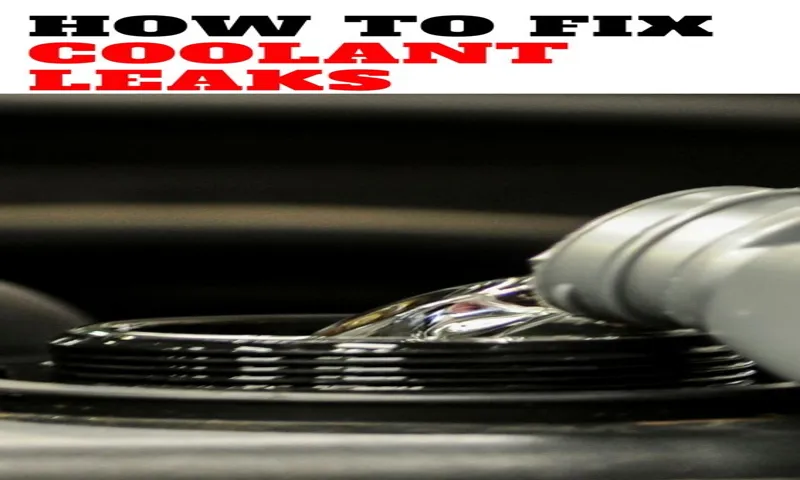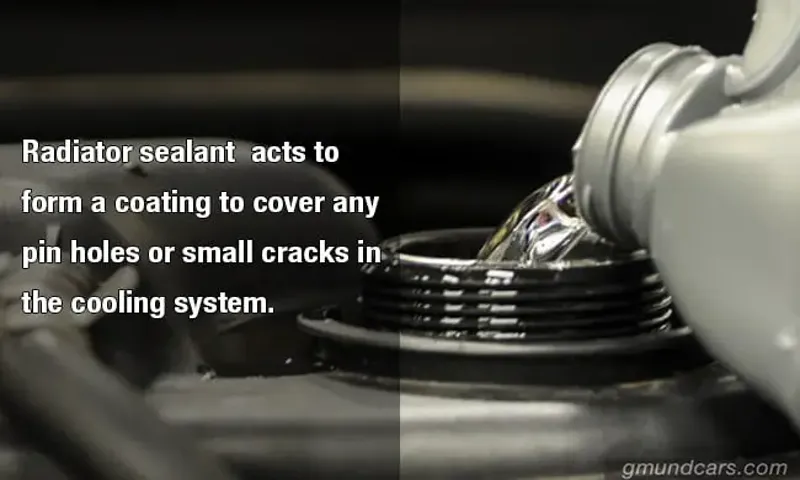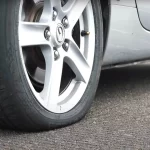Having a coolant leak in your vehicle is never a good sign. Not only can it lead to engine overheating, but it can also cause significant damage to various components, ultimately leading to costly repairs. That’s why it’s crucial to address a coolant leak as soon as possible to avoid any further complications.
But where do you start? How can you fix a coolant leak without the help of a mechanic? Don’t worry – we’ve got you covered. In this step-by-step guide, we’ll walk you through the process of fixing a coolant leak, saving you time and money in the process. So grab your toolbox and let’s get started!
Table of Contents
Identifying the Coolant Leak
If you’ve noticed that your car is losing coolant but you can’t seem to find the source of the leak, you’re not alone. Coolant leaks can be sneaky, and sometimes it takes a bit of detective work to track them down. One method is to visually inspect the engine for signs of coolant dripping or pooling.
Look for visible wet spots or residue on hoses, connectors, and the radiator. Another method is to use a coolant pressure tester, which pressurizes the coolant system to help identify leaks. It’s also important to check the radiator cap, as a faulty cap can cause coolant to escape.
Additionally, keep an eye out for white exhaust smoke, as this can indicate a coolant leak into the engine cylinders. Once you’ve identified the source of the leak, fixing it will depend on the specific issue. It could be something as simple as tightening a loose hose clamp or replacing a faulty gasket.
In more severe cases, such as a cracked radiator or a leaking water pump, you may need to seek professional assistance. Remember, it’s important to address coolant leaks promptly to prevent engine overheating and potential damage. So, if you suspect a coolant leak in your car, don’t wait – start investigating and fixing the issue as soon as possible.
Inspecting the Engine
coolant leak, engine inspection

Checking the Radiator
When it comes to maintaining your car’s cooling system, checking the radiator is a crucial step. One common issue that many drivers face is a coolant leak. Identifying a coolant leak early on is essential to prevent any further damage to your vehicle.
So, how can you spot a coolant leak? Well, keep an eye out for any wet patches or puddles under your car. Coolant is usually colored and has a distinct sweet smell. Another telltale sign of a coolant leak is an overheating engine.
If you notice that your engine temperature is rising rapidly, it could be due to a coolant leak. In such cases, it’s important to check the radiator for any signs of a leak. Don’t let a coolant leak ruin your driving experience or potentially cause expensive repairs.
Stay proactive and keep an eye out for any signs of a coolant leak.
Common Causes of Coolant Leaks
Are you noticing a strange puddle forming under your car? It could be a coolant leak. Coolant, also known as antifreeze, is an essential fluid that helps regulate the temperature of your engine. When there is a leak in your coolant system, it can cause overheating and potential damage to your engine.
Some common causes of coolant leaks include a faulty radiator, a cracked coolant hose, or a damaged water pump. If you’re wondering how to fix a coolant leak, it’s best to have a professional inspect and diagnose the issue. They can determine the exact cause of the leak and provide the appropriate solution, whether it’s repairing or replacing the affected component.
Remember, it’s important to address coolant leaks promptly to prevent further damage to your vehicle.
Damaged Hose
coolant leaks, damaged hose, common causes
Faulty Radiator
radiator, coolant leaks
Loose or Damaged Coolant Cap
Loose or Damaged Coolant Cap One common cause of coolant leaks in a vehicle is a loose or damaged coolant cap. The coolant cap is responsible for maintaining the proper pressure in the cooling system, which helps prevent leaks. If the cap is loose or damaged, it can allow coolant to escape, resulting in a leak.
This can happen over time as the cap wears out or if it is not properly tightened after performing maintenance on the cooling system. A loose or damaged coolant cap can lead to a decreased pressure in the system, which can cause coolant to boil at a lower temperature. This can result in overheating of the engine and potentially even engine damage if not addressed promptly.
To prevent coolant leaks from a loose or damaged cap, it is important to regularly check the cap for any signs of wear or damage. If the cap appears to be worn or is not securely tightened, it should be replaced. It is also essential to ensure that the cap is properly seated on the coolant reservoir to maintain the correct pressure in the system.
In conclusion, a loose or damaged coolant cap is a common cause of coolant leaks in vehicles. Regularly checking and maintaining the cap can help prevent leaks and ensure that the cooling system is functioning properly. Don’t overlook the importance of a small and seemingly insignificant cap, as it plays a vital role in keeping your engine cool and preventing potential damage.
Fixing the Coolant Leak
Have you noticed a puddle of liquid under your car or a sweet smell coming from the engine? These could be signs of a coolant leak, which is not something to ignore. Coolant, also known as antifreeze, is crucial for regulating the temperature of your engine and preventing it from overheating. If you suspect a coolant leak, there are a few steps you can take to fix the issue.
First, locate the source of the leak. This could be a cracked hose, a loose connection, or a faulty radiator. Once you’ve identified the problem area, you can decide whether to repair or replace the damaged component.
If it’s a minor issue, such as a loose hose clamp, you may be able to tighten it yourself. However, for more serious leaks, it’s best to consult a professional mechanic. They have the expertise and tools to properly fix the problem and ensure it doesn’t happen again.
Remember, taking care of a coolant leak promptly can save you from more serious engine damage down the road. So, if you suspect a leak, don’t delay in getting it fixed.
Replacing a Damaged Hose
Replacing a Damaged Hose
Repairing a Faulty Radiator
faulty radiator, coolant leak, repairing radiator, fixing coolant leak
Tightening or Replacing the Coolant Cap
coolant leak
Preventative Measures
If you’ve discovered a coolant leak in your vehicle, it’s important to address the issue as soon as possible to prevent further damage to your engine. So, how do you fix a coolant leak? One preventative measure you can take is to regularly inspect your coolant hoses and connections for any signs of wear or damage. Over time, hoses can deteriorate or develop small cracks, leading to leaks.
If you notice any issues, such as bulges, cracks, or leaks, it’s best to replace the hose before it becomes a larger problem. Additionally, checking the tightness of your hose clamps and connections can also help prevent coolant leaks. These clamps can become loose over time, causing coolant to seep out.
By ensuring they are tightened properly, you can help prevent leaks. Another preventative measure is to regularly monitor your coolant levels and keep them topped up. Low coolant levels can put additional stress on your engine and increase the risk of leaks.
Finally, it’s a good idea to check your radiator for any signs of damage or corrosion. Over time, radiators can develop leaks or become blocked, leading to cooling system issues. By addressing any issues early on, you can avoid larger problems down the road.
In conclusion, proactive maintenance such as regularly inspecting hoses, checking clamps, monitoring coolant levels, and inspecting your radiator can help prevent coolant leaks and keep your engine running smoothly.
Regular Maintenance
One of the most important aspects of maintaining your vehicle is regular maintenance. Preventative measures can help to keep your car running smoothly and prevent costly repairs down the line. Regularly checking and changing the oil, replacing filters, and inspecting belts and hoses are all essential tasks that can extend the life of your vehicle.
Just like going to the doctor for an annual check-up, taking your car in for routine maintenance can catch small issues before they become major problems. It’s like giving your car a tune-up to keep it performing at its best. So, don’t neglect your vehicle’s needs – take the time to give it the care it deserves and enjoy worry-free driving.
And remember, an ounce of prevention is worth a pound of cure!
Checking Coolant Levels
checking coolant levels Prompt: Checking coolant levels is an essential part of maintaining the health and performance of your vehicle. Coolant, also known as antifreeze, is responsible for regulating the temperature of your engine. Without proper cooling, your engine is at risk of overheating and causing serious damage.
By regularly checking and maintaining proper coolant levels, you can help prevent costly repairs and keep your vehicle running smoothly. In order to prevent any unexpected complications or expenses, it is crucial to include the task of checking coolant levels in your regular vehicle maintenance routine. This simple yet important step can help ensure that your engine stays cool and avoids any potential overheating issues.
Coolant, or antifreeze, is responsible for regulating the temperature of the engine, therefore keeping it at optimal levels. Without sufficient coolant, the engine can easily overheat, leading to severe damage and expensive repairs. By taking the time to check and maintain proper coolant levels, you are taking a proactive approach towards the health and performance of your vehicle.
Regularly checking coolant levels not only helps in avoiding potential engine damage but also enables you to identify any leaks or issues with the cooling system. Insufficient coolant levels or a sudden drop in levels could be indicators of a leak or malfunction in the system, which should be addressed promptly to prevent any further damage. Moreover, checking coolant levels can give you an idea of how frequently your vehicle may require topping up or a coolant change.
By keeping an eye on the coolant levels, you can plan ahead and ensure that the necessary maintenance tasks are performed in a timely manner. This will not only help in preserving the efficiency and longevity of your vehicle but also save you from unexpected and costly repairs in the long run. Checking coolant levels is a simple procedure that can be done by almost anyone.
To start, ensure that your engine is cold before opening the hood. Locate the coolant reservoir, usually a semi-transparent tank with the word “coolant” labeled on it. The reservoir will have minimum and maximum marks indicating the ideal coolant levels.
Using Coolant Leak Sealants
Using coolant leak sealants is a great way to prevent potential problems with your vehicle’s cooling system. Coolant leaks can lead to overheating and engine damage, so it’s important to address them as soon as possible. Sealants are designed to temporarily patch or seal small leaks in the cooling system, allowing you to drive your vehicle safely until you can address the issue properly.
By using a coolant leak sealant, you can buy yourself some time to either schedule a repair or purchase the necessary parts to fix the leak yourself. It’s important to note that coolant leak sealants are not a permanent solution, but they can be a helpful tool in preventing further damage to your vehicle. So, if you notice a coolant leak in your vehicle, consider using a sealant as a temporary fix until you can address the issue properly.
Conclusion
In the epic battle of man versus coolant leak, there are various methods to emerge victorious. Much like a skilled surgeon, one must diagnose the issue, locate the source of the leak, and initiate the repair with grace and finesse. Whether it be a simple seal replacement or the installation of a high-tech patch, one thing is certain – we shall not surrender to the pesky drips and puddles that threaten the sanctity of our vehicle’s performance.
With the precision of a master craftsman and the determination of a tenacious squirrel hoarding acorns, we shall conquer the coolant leak and restore our chariot to its former glory. So fear not, fellow drivers, for in the realm of coolant leaks, there is but one ultimate solution – our wit, ingenuity, and the everlasting pursuit of a leak-free existence. Let us tighten those bolts, seal those cracks, and bask in the satisfaction of a job well done.
And remember, when life gives you a coolant leak, fix it with flair and thumb your nose at the fickle whims of automotive challenges!”
Keeping Your Engine Cool and Leak-Free
cooling system, engine overheating, coolant leaks, preventative maintenance, radiator flush, thermostat replacement, regular inspections, coolant levels, water pump, hoses and belts.
FAQs
How do you fix a coolant leak in a car?
To fix a coolant leak in a car, you first need to locate the source of the leak. This can be done by inspecting the radiator, hoses, water pump, and radiator cap. Once you have identified the source, you can determine if a repair or replacement is needed. Common fixes for coolant leaks include replacing a faulty radiator hose, tightening loose clamps, or replacing a damaged water pump.
What are the signs of a coolant leak?
There are several signs that indicate a coolant leak in a car. These signs include a strong sweet smell inside the car, visible puddles of coolant under the vehicle, overheating engine, low coolant levels in the radiator or reservoir, and a sudden drop in the car’s performance. If you notice any of these signs, it is important to address the issue promptly to avoid further damage to the engine.
Can a coolant leak be fixed with a sealant?
Yes, certain coolant leak sealants can temporarily fix small leaks in the cooling system. These sealants work by circulating through the system and sealing the leaks from the inside. However, it is important to note that this is a temporary solution and should only be used as a temporary fix until you can get the proper repairs done. Using a sealant for a long period of time can cause further damage to the cooling system.
How much does it cost to fix a coolant leak?
The cost of fixing a coolant leak can vary depending on the source of the leak and the type of repair needed. On average, the cost can range from $150 to $500. This cost can include the labor fees, replacement parts, and coolant fluid. It is always recommended to get a quote from a trusted mechanic or repair shop to get an accurate estimate for your specific situation.
Can I drive with a coolant leak?
Driving with a coolant leak is not recommended as it can lead to severe engine damage. Coolant is responsible for regulating the engine’s temperature, and a leak can cause the engine to overheat. Overheating can warp cylinder heads or even cause a complete engine failure. If you suspect a coolant leak, it is best to address the issue immediately and avoid driving until the problem is resolved.
How long does it take to fix a coolant leak?
The time it takes to fix a coolant leak can vary depending on the severity of the leak and the availability of replacement parts. In some cases, a coolant leak can be fixed within a few hours, while more complex leaks may require a day or more of labor. It is best to consult with a professional mechanic to get an accurate estimate of the repair time for your specific situation.
Why is my car leaking coolant?
There are several reasons why a car may be leaking coolant. Some common causes of coolant leaks include a cracked radiator, a worn-out hose or gasket, a faulty water pump, a loose radiator cap, or a damaged heater core. It is important to identify the source of the leak to determine the appropriate repair needed. If you are unsure of the cause, it is best to consult with a mechanic for a proper diagnosis.



